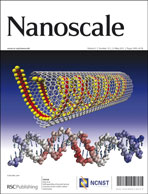Reversible photo-chem-electrotriggered three-state luminescence switching based on core–shell nanostructures†
Abstract
Reversible three-state fluorescence switches triggered by light, electricity and chemical inputs based on “sponges” of Pyronin Y-doped silica nanoparticles (PYDS) and polyoxometalate K14[Na(H2O)P5W30O110] (Na-POMs) core–shell nanostructures were realized. Under one or two signal inputs, the system exhibited distinct three-state interconvertible automaton, achieving reversible “on” and “off” luminescence switches via the related luminescence quenching effect. The features of the system correspond to the equivalent circuitry of an IMPLICATION logic gate performing the Boolean operation by using potential and chemical as inputs. Such a multi-chromic device with novel structure possesses several advantages, such as relative low operation voltage, large reproducibility and reversibility, apparent fluorescence contrast, and long-time stability, which make it a suitable candidate for nonvolatile memory devices. In addition, the current protocol for the hybrid film fabrication can be easily extended from the polyoxometalate and organic dyes to other novel nanostructures matched multifunctional stimulus-responsive species and fluorescence materials in the future.


 Please wait while we load your content...
Please wait while we load your content...